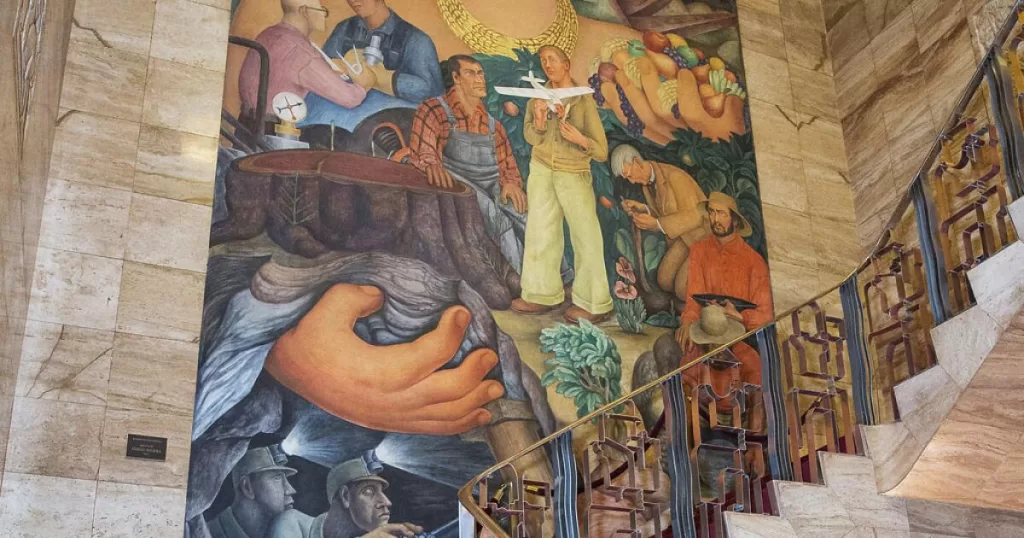The industry and extraction shown here convey one version of California’s history — the version long reinforced in schools, in which much of California’s origin story has been wrapped up in the Gold Rush. However, the woman at the center of the mural represents a much older theme, one woven through history in Europe and Africa, one captured unwittingly in fiction 500 years ago, one that repeated itself in North America and gave rise to the state we know today.
The face of Rivera’s painted woman was based on Olympic gold medalist Helen Wills, but the character is inspired by “The Adventures of Esplandián,” a 16th century novel by Castilian author Garci Rodríguez de Montalvo. The tale’s antagonist, Calafia, is the powerful Muslim queen of a faraway land of bounty called California. She sails into battle with an army of women, fighting against the Spanish military, depicted as forces for goodness and Christianity.
Montalvo had spent his early adulthood as a soldier in the army of Ferdinand and Isabella, the famous royal duo who drove Muslim rulers out of the Andalusian peninsula in 1492 — the same year their explorer Christopher Columbus reached North America. When Montalvo penned his later fictional battles, he explicitly drew on those Andalusian wars.
Scholars speculate that his Queen Calafia is based on a real Muslim queen who began a piratical career as revenge against the Spanish kingdom that had driven her family out of their ancestral home and into the mountains of Morocco. This was Sayyida al Hurra.
She rose to power around the turn of the 16th century, becoming an independent queen in the Moroccan citystate of Tétouan. She either became a privateer herself, taking to the Mediterranean Sea to attack Spanish holdings such as Gibraltar, or she licensed privateers to attack Spain in her name. She was an ally of the pirate and Ottoman leader Khayr al-Dīn, better known in the West as Barbarossa or Redbeard. They harried the Spanish and Portuguese royal navies, simultaneously enriching their people and ensuring the Spanish knew that their cruelty had been neither forgotten nor forgiven.
It’s not entirely certain that this Moroccan pirate queen was the inspiration for Montalvo’s fictional queen, but the resemblance is uncanny. Both were powerful, independent Muslim women who valiantly fought the Spanish on land and on water. And both fell from power.
Al Hurra was deposed by her son-in-law. In Montalvo’s story, Queen Calafia is captured by the Spanish. She’s Christianized, married off and tamed. When she is released, she swears to return to her homeland and disband the power structures that prize women’s perspectives, so the land of California would favor masculine and Christian power.
The tale of Spanish victory was a sensation in Spain. The earliest extant copy, from 1519, shows that it went through many editions and reprintings. When Spanish conquistador Hernán Cortés took his final expedition in 1536 and saw the western coast of North America, he called it California, borrowing the name from Montalvo’s romance.
The name stuck. Centuries later, just as the Gold Rush was getting started, part of the coast became the state of California in 1850. The link to the 15th century Spanish wars against “infidels” might have been lost on American leaders of the 19th century, but now we can see how Calafia mirrors the troubling history of colonization and domination that created California.
Like the tales of Queen Calafia and Sayyida al Hurra, the story of California hinges on European invasion and displacement. Spanish colonizers swarmed the West Coast, capturing and forcibly Christianizing the Chilula, Chimarike, Karok, Shasta, Tolowa, Wiyot and Yurok tribes over time. People were driven from their ancestral lands in violent ways that upended entire cultures. In the name of progress, much was lost and destroyed. Their stories were erased in favor of myths of European “discovery,” American exceptionalism and Christian destiny. To the victor, the myth-making. But when those victors named California, they embedded more in the mythology than they intended.
Google Books, which can track appearances of a particular word or phrase in written sources between 1500 and 2019, shows that “Calafia” has surged in use in a pattern that mirrors interest in the history of California at various moments. Usage has ticked upward in recent years, reflecting an interest in highlighting the influence of marginalized peoples in American history. The rising trajectory in 2019 hints at the surge in interest in marginalized histories that would come in 2020 alongside the Black Lives Matter movement.
The steep peak around 1926 presaged Rivera’s use of Calafia in his mural in the early 1930s. Intentionally or not, Rivera’s depiction of the Spirit of California is troublingly in line with how Montalvo’s story ends: Other than the towering queen, the mural depicts mostly men whom she supports in her arms; their work comes from her support and offering. The once-powerful Muslim queen’s face, transformed into the likeness of a beautiful white tennis player, exists only as a symbol of beauty and progress.
Centuries of retelling seem to have stripped al Hurra’s life story of her power as an African queen, as an avenging pirate. She became Montalvo’s Calafia, who was subjugated by Spain. Calafia became Rivera’s Spirit of California, a backdrop for men felling trees and mining. The arc of this figure through history and fiction traces the destruction of feminine and Indigenous power in favor of white, Christian patriarchy. An allegory of California indeed, and one that only recently seems to be coming to an end.
Valorie Castellanos Clark, a writer and historian in Los Angeles, is the author of the forthcoming “Unruly Figures: Twenty Tales of Rebels, Rulebreakers, and Revolutionaries You’ve (Probably) Never Heard Of.”
